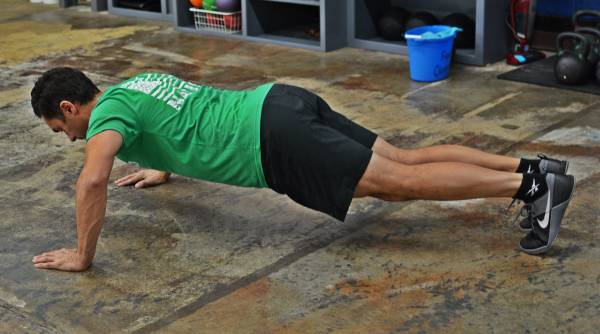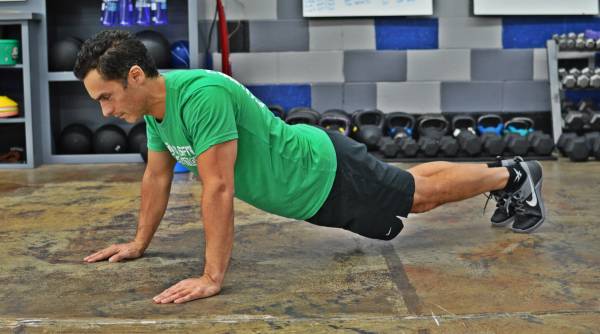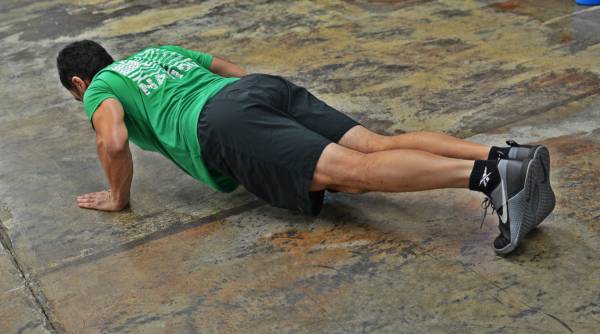As a physical therapist, I often hear complaints of wrist pain during push ups. While this could indicate an injury, it more often means you need to tweak your form. The good news is, you can get rid of this pain simply and easily. This article will outline some of the common mistakes that lead to wrist pain, and how to put them right.
Evaluate Your Current Push Up
Get into the starting position of a push up.
- Where are your hands?
- Where are your hands in relation to your shoulders?
- What contact do you have with the ground underneath you?
- Where are your elbows and shoulders?
- What about your trunk, hips, and upper back?
As you can see, there is a lot to think about when evaluating your push up. Let’s get to the answers.
Hand Position
Beginners tend to keep their hands wide and far in front of the chest. They also relax their hands and fingers. Sometimes I even see people rotate their hands in one direction or another. All these positions place unnecessary strain on the wrist, leading to pain.
To avoid wrist pain, your hands should be about shoulder width apart and close to your chest. At the top of the push up, your hands should be directly under your shoulders. Placing your hands in front of or behind the shoulder will increase pressure on your wrists.
Your hands should be facing forward, not angled, and all parts of your hand should make contact with the ground. Avoid cupping the palm or lifting up your fingers. If you do this, the heel of your hand will take on all of the pressure and force, which inevitably leads to some wrist discomfort. Ensure all parts of your hand and fingers are in contact with the ground to better disperse the force and avoid pain.
(Note: If you use Perfect Pushup handles, your palms should face each other at the top of your push up and face backwards at the bottom.)
How NOT to do a push up:
- The hands are above the line of the shoulder and not flat on the ground.
- The back is in downward dog position. It should be flat.
- The elbows are flared out instead of tucked in.
Rotating the hands places unnecessary strain on the wrist, leading to pain.
Elbow Position
Watch a beginner do a push up and you will often see the elbows flared straight out to the side. People who haven’t done push ups are usually stronger in this position, as it helps compensate for weaknesses. The problem is, flared elbows can lead to regular pain in the wrist, as well as more serious wrist, elbow, and shoulder injuries.
Remember, your hands should be under your shoulders and close to your chest. Your elbows should be back at about 45 degree angle, not flared out beside you.
How NOT to do a push up:
- The elbows are flared out and hands are wide.
- The hands are cupped.

Flared elbows can lead to regular wrist pain, as well as more serious injuries.
Trunk Position
Lack of trunk engagement leads to a sagging torso. Believe it or not, this position can also lead wrist pain, since it puts extra pressure on them.
Your body should lift and lower as a unit. If you feel any sway in the spine or sag in the hips, it indicates a lack of core stability. Be mindful of not letting your back sway or hips sag. If you can’t stop this from happening, talk to your coach. You might need to work on a variation to build strength, such as an eccentric push up or an incline push up.
How NOT to do a push up:
- The hips are sagging.
- The lower back is arched.

If your hips sag, you need to work on core stability.
What a Proper Push Up Should Look Like
- The hands are firmly on the ground, with no cupping of the palms.
- The hands are below the line of the shoulder.
- The elbows are at an angle – approximately 45 degrees.
- The core is engaged and the body moves as a unit.
- The head is in a neutral position, not looking down.

By perfecting your form, you should be able to eliminate wrist pain.
If You Still Feel Wrist Pain
If the above form fixes don’t help your wrist pain, you may have weak wrists or lack range of motion. In this case, I recommend going to see a physiotherapist who can assess your wrists and give you specific instructions.
Until then, incorporate some knuckle push ups in your program. These will ensure your wrists are aligned. Do them on a mat until you get used to the pressure on your knuckles, since they can be a bit painful at first. If you continue to have wrist pain even while doing push ups on your knuckles, stop until you’ve consulted with your physiotherapist to prevent further injury.
More Tips to Perfect Your Push Ups:
- Why Knee Push Ups Won’t Make You Any Stronger
- How to Progress Your Way to a Perfect Push Up
- For the Push Up Pros: Can You Do All These?
- New on Breaking Muscle Today
Photos courtesy of CrossFit Dedication.






